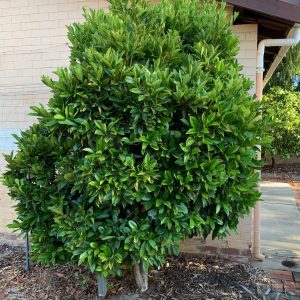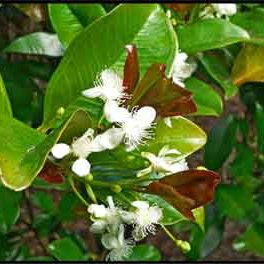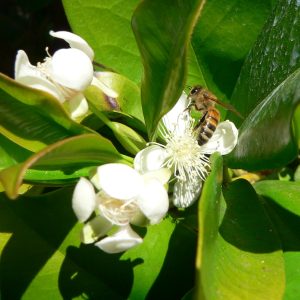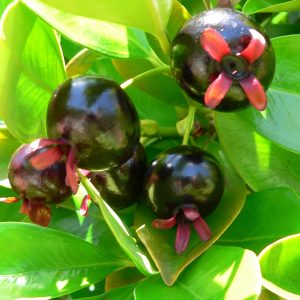Eugenia brasiliensis (dombeyi)
Grumichama, Brazil cherry
Origin
Indigenous to coastal areas of south east Brazil. Since distributed to Australia and elsewhere.
Climate
It is a sub-tropical species. Mature plants can handle light frosts and will survive drought periods, but cropping deteriorates without regular rainfall or irrigation. Optimal production is obtained with more than 1500mm pa, well-distributed throughout the year.
Plant Description
It is a highly ornamental, erect evergreen tree to 10m high, multi-stemmed or with a short trunk. It has a dense canopy with glossy deep green leaves.
Relatives
Myrtaceae Family. There are more than 30 species with edible fruit in the genus Eugenia, including pitanga, cherry of the Rio Grande and pitomba. There are many others in the closely related genus Syzygium.
Soils
Largely undemanding of soil types provided they are well-drained, with a preference for deep, slightly acid, sandy loams.
Propagation
Seed is usually used, with use of cuttings for selected superior plants. Grafts may promote suckering.
Cultivars
No widely accepted named cultivars.
Flowering and Pollination
Inflorescences are predominantly axillary, with flowers either solitary or in clusters on long peduncles. They have green sepals, white petals and numerous white stamens with yellow anthers and an inferior ovary. Little is recorded on pollination in this species, but they are self-fertile, and if similar to other Eugenias, bees and sometimes moths would be the pollinators.
Cultivation
They prefer partial shade but will produce fruit in full sun. Growth is slow when young and it may take several years before the plant is 2m high. If planted closely as a hedge where there will be root and light competition, productivity will be compromised. Weed control is important in the establishment years. A complete NPK fertilizer with trace elements should be applied regularly and in proportion to tree size.
Wind Tolerance
Little tolerance when young.
Pruning
Minimal to control shape, remove any dead wood and maintain at no more than 3m height. Fruit yield may be decreased if this is too vigorous.
The Fruit
The fruit is a berry. Three types are found, with black skin the most common and less frequently, yellow and red. There is no great difference in flavour between these. They are oblate, 1-2 cm wide, on a long peduncle and turn from green to red, then their final colour, usually black, as they mature. The dark-coloured sepals remain at the fruit apex. The skin is thin and the flesh white or varying shades of red, juicy, aromatic and sub-acid and contains about 13% sugars and, for a fruit, good levels of calcium. There may be 1-4 large greenish-grey seeds which are not eaten.
Fruit Production and Harvesting
Fruit production may commence 4-5 years after planting seedlings. There could be more than one crop per year but the first is usually the biggest. They are very productive and well-managed trees can produce 15-25kg of fruit per season.
Storage life at room temperature is only 4-5 days but if chilled this can be slightly extended.
Fruit Uses
Usually eaten fresh but can be made into jellies and preserves.
Pests and Diseases
Not serious, but Med fly can be a problem as can birds.
Comments
A very attractive specimen that can produce lots of tasty fruit if its water requirements are met.



